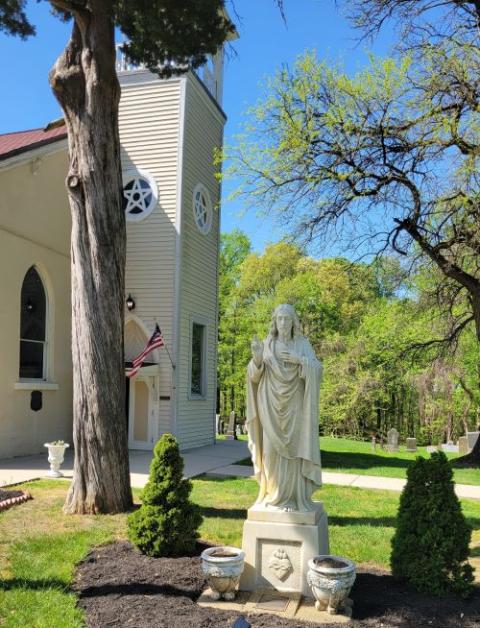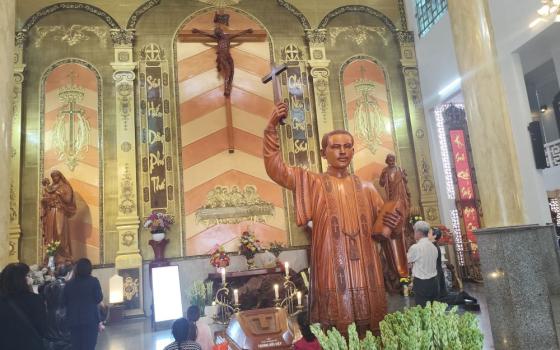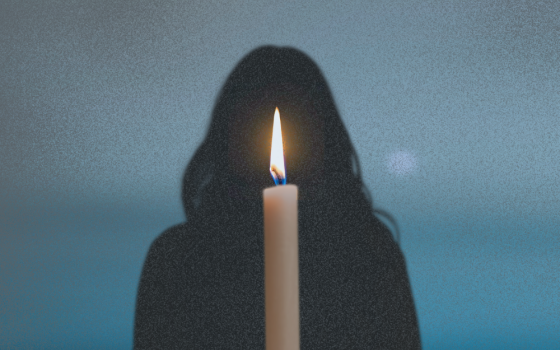I clearly remember the day in 1985 when I gathered with my eighth-grade classmates for our confirmation retreat at the historic Sacred Heart Chapel in Bowie, Maryland. I remember receiving a letter I received from my older brother Michael, my confirmation sponsor, encouraging me to grow in my relationship with God and to embrace my responsibility as a Christian to serve the common good. My other clear memory of that day is taking a quiet and prayerful solitary walk through the cemetery on the grounds, wondering about the lives of those buried there.
The historical marker on Annapolis Road just down the hill from the chapel tells the story of this place — or, rather, one side of the story. Sacred Heart Chapel, the oldest Catholic Church in Prince George's County, was built by the Jesuits on the White Marsh property (now Bowie) in 1741. The Jesuit Maryland Province novitiate was located on the grounds for a time in the 1800s. John Carroll was nominated to be the first American bishop at a meeting there in 1879. The marker also includes a passing reference that the Jesuit "priests turned their 2,000 acre bequest into a thriving plantation." There is no mention of the people who were enslaved and forced to farm tobacco and other crops there to support the Jesuit priests and fund their mission. (More on that later.)
Earlier this year, a story appeared on my social media feed about the cemetery at Sacred Heart Chapel. It was not about the graves I walked among that day, with their inscriptions on the white marble markers memorializing the names of the (also white) people buried below.
Instead, the article featured a picture of Washington Cardinal Wilton Gregory presiding at a prayer service honoring the hundreds of people buried in the recently unearthed area just beyond the pristinely maintained parish graveyard. These unmarked graves, presumably holding the remains of people enslaved by the Jesuits on the White Marsh plantation, had been there all along, hidden under branches and groundcover in the woods nearby.
Advertisement
My heart stopped as I remembered my prayer the day of my confirmation retreat, in what I now considered to be the white graveyard. I was saddened that while I had reflected then about the lives of those white members of the communion of saints, I had not known that these other souls were also buried in that sacred space. My ignorance of those hidden graves meant that I missed the opportunity to remember them and reflect on their joys, pains, sorrows and celebrations as I prepared for my confirmation.
The Catechism of the Catholic Church (1285) quotes from Pope Paul VI's 1964 Lumen Gentium (11) when speaking of the power and promise of the sacrament of confirmation. Shortly after that retreat, my classmates and I received the sacrament through which we were meant to be "more perfectly bound to the Church." Which church, I now found myself wondering? The church that enslaved generations of human beings for profit? The church that hid or ignored this history for convenience? Or the church that re-members — finds and claims those who have been lost — and seeks reconciliation and restorative justice?
In his homily that day, Cardinal Gregory pointed to the overdue hope and promise of my questions. He said:
We are trying to, to the best of our ability, allow the people whose lives were bound up in slavery and whose death mattered little to those who survive them, we are trying to make sure that their lives are not lost, but more importantly, that their memories are not lost.
I played soccer as a young girl at White Marsh Park, not far from Sacred Heart Chapel, land that must also have been part of the Jesuit's White Marsh plantation. I pray for the generations of enslaved children who worked the land where I played. I hope that they also experienced the joy of play on land where generations of suburban children have since had that privilege.
U.S. Census records show that the majority of Bowie's residents today are African American (57.9%), while 29.6 % are white. This reflects a major demographic shift from the time of my mostly white childhood in the 1970s and 1980s. When my parents bought their first house in the new Belair at Bowie development in 1961, developed by Levitt and Sons, discriminatory racial practices meant that only white families were allowed to purchase the newly built homes. Consequently, my entire eighth-grade Catholic school class was white, with the exception of one African American classmate who commuted from a nearby town.
The development was built on the grounds of the former Belair estate, another plantation property where enslaved men, women and children were forced to work. Census records from 1865, after slavery was finally outlawed in Maryland, record that among the 41 enslaved people at Belair were Cecilia (8 years old), Edward (6 years old), Emily (4 years old), Eliza (3 years old) and an unnamed 2-year-old. As I reflected in an earlier Global Sisters Report column:
I catch my breath now, now recognizing that enslaved children worked where I played, even if centuries earlier. They worked land where 100 years later, other Black families were not given the same opportunity as my white parents to buy a newly built affordable home on that same land.
It is important to re-member those who were lost in the telling of our history, to bring them into the whole fabric of our story, the good and the bad. We are better for the bringing together of all the members of our human family into our memories. The first step is telling the truth, no matter how hard it is to face.

Sacred Heart Chapel dates to about 1741 and was built by Jesuits on the property known as White Marsh. Nearby graves are thought to hold the remains of people enslaved by the Jesuits. (Susan Rose Francois)
I am grateful to the research of Rachel Swarns in her new book, The 272: The Families Who Were Enslaved and Sold to Build the American Catholic Church. I was mesmerized by the story she weaves in this difficult, yet critical, book, tracing the story of one family that was descended from Ann Joice.
While the first Jesuits arrived in Maryland in 1634 — a fact I learned to be proud of in my Catholic school history class — Ann Joice arrived in 1676 as a teenager indentured to Charles Calvert, son of one of the founding Catholic families of the Maryland colony. When Calvert returned to England, Joice was sent to one of Calvert's cousins, Henry Darnall. Oral history passed down through Joice's descendants tells us that Darnall burned the woman's indenture papers and doomed her and her progeny to enslavement, a good number of whom would be enslaved on Jesuit plantations in Maryland, including White Marsh.
The story does not end there, however. Swarns deftly weaves the story of the Jesuit community's history as owners of human beings, the application of the profits of their labor to support the Jesuit mission including educational institutions such as Georgetown, and the larger Catholic Church’s murky history of racial injustice with the generational stories of Ann Joice's descendants.
Two of those descendants, Jeremy Alexander and Melissa Kemp, have joined other descendants of the 272 people sold in 1838 by the Jesuit community to re-member their ancestors and seek justice from Georgetown University and the present-day Jesuit community. This work is good, necessary and important for all Catholics, not just those with direct ties to these dangerous memories.
Returning to the catechism on the sacrament of confirmation, the point is not just to be more perfectly bound to the church. Rather, we are bound together "as true witness of Christ, more strictly obliged to spread and defend the faith by word and deed." Together, we must acknowledge our history of racial injustice and walk the path of reconciliation and restorative justice today and into tomorrow.






